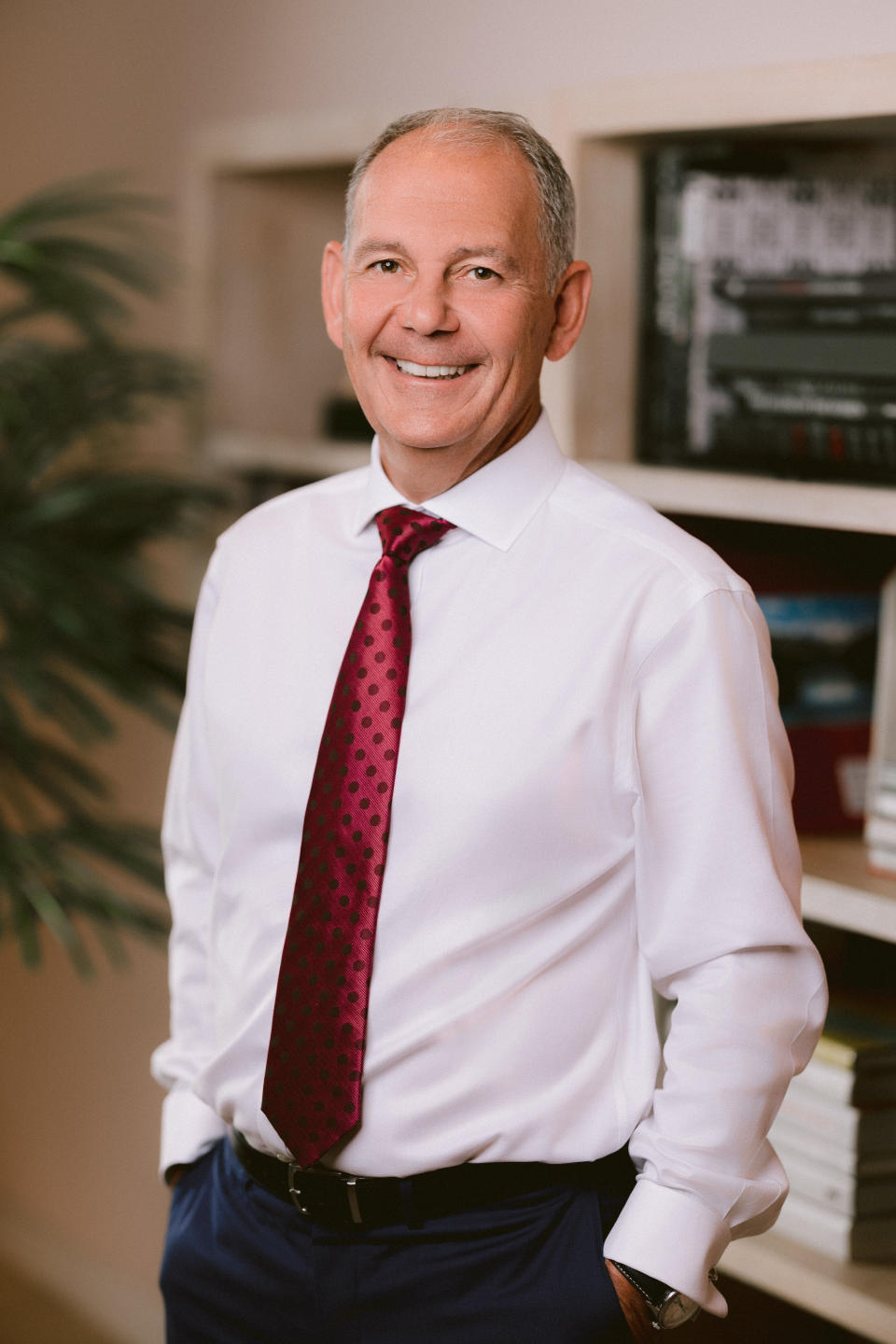Victoria’s Secret Lays Out Next Transformation Steps During Investor Day

CHICAGO — Martin Waters’ makeover of Victoria’s Secret is still evolving.
As of now it includes pivoting onto a global stage, a revision of the store fleet, an update on the fashion assortment (additions such as adaptive wear, maternity bras and period panties, as well as personal care and home fragrances) and a greater emphasis on the core lingerie segment, all in the hopes that Victoria’s Secret will be the leading lingerie retailer around the world, not just in the U.S.
More from WWD
It’s an ambitious plan, Waters admitted — “that will be a lifetime of work in the next three years” — and slightly larger than the company’s previous plans to become an advocate for all women. But the chief executive officer is doing it by focusing on what the new Victoria’s Secret (now known as VS & Co.) is, even if the retailer has lost the attention of some consumers in recent years.

“The reality is, for many people, they just haven’t noticed [the transformation]; they haven’t had the occasion to either come to our site and see what the change looks like, or come to our stores and see what the change looks like,” Waters told WWD in an exclusive interview. “But we know from our research that when those people do discover the new Victoria’s Secret, they love it. They absolutely love it and say, ‘Wow. Thank you. We really appreciate the way you’re showing up now.’”
Waters, along with other members of the C-suite and analysts, descended upon the Windy City on Thursday for Victoria’s Secret’s investor day, the first as a stand-alone company. It was a chance for the CEO to update the investment community on the retailer’s turnaround progress — which he stressed was only in year two out of five — while also addressing the proliferation of brands entering the space and how Victoria’s Secret will continue to compete.
“In the old version of Victoria, everything the brand did, or that was said, or publicized or produced, was done because it fitted one single word, one single definition of what the customer needed and that was ‘sexy,’” Waters said. “And for a long period of time that worked for who we were. That was a really, really good thing to do, just working in a mall. But what we are now is advocacy for women. So our lens in looking at what women should do is completely different than what it was. We look at what women want as what we should do. That’s just opened up a whole world of opportunity. And having that freedom to express the brand in that way is incredibly liberating.
“There’s a number of digital brands that didn’t exist eight, 10 years ago,” he added during his prepared presentation. “They got to about $1.8 billion in overall revenues, a pretty significant share of the market for lots of companies that individually are quite small. But in aggregate it is an important part of the market. There’s a lot of stuff around us. And when you talk to those companies — I won’t mention them by name, any of them — when you talk to them and say, ‘tell me why you exist? What’s your [unique selling proposition]? What’s your point of difference? Why are you here?’ The first thing they say, typically, is a response to what Victoria’s Secret is not. But many of these brands that are close to our core exist because we were not what we should have been. That’s a really important insight for us in terms of where we take this company moving forward.”
It’s not hard to understand why Waters was hesitant to talk about the competition. Many investors and consumers alike are still reeling from former L Brands’ chief marketing officer Ed Razek’s slights against competitor ThirdLove back in 2018, in an interview that included less-than-flattering comments regarding plus-size and transgender models.
But the CEO did mention a few favorites. The list includes Elomi and Leonisa, both of which are available on the VS&Co-Lab site, for which he praised their inclusive offerings and shapewear assortment; Shein (he’s a fan of their data use), and American Eagle Outfitters’ Aerie.
In the case of the latter, Waters said, “I don’t think they’re a direct competitor. Our business is a lingerie business. We’re first and foremost a lingerie business. I wouldn’t say that about Aerie. Aerie is more an apparel business that sells some lingerie. Do we have a crossover in customers? Of course we do. We play in the same worlds. But I don’t worry about them. I don’t think they worry about us. There’s an enormous pie to go around. There’s a $16 billion business that we’re fortunate to have a big slice in.”
The path forward then entails a greater focus on “expanding the core” — perhaps the most overused buzzword of the day — lingerie business.

“We don’t want to be in the basics business,” Waters explained. “We think our added value comes from being a fashion company. Intimates needs to be north of 50 percent of our business; ideally north of 55 percent. We’re an intimates business and we need to leverage that strength. The heart of the business is bras. That means new innovation, new launches. The category we talk about most is bras.”
The all-day investor event helped the company’s stock close up 10.2 percent to $35.81 a share Thursday. So did Wednesday evening’s news that the retailer has updated its third-quarter outlook. Victoria’s Secret is now expecting earnings toward the high end of its previously communicated guidance of 0 to 25 cents per diluted share. The firm also anticipates operating income toward the high end of previously communicated guidance range of $10 million to $40 million. Both expectations are based on a net sales decline in the high-single-digit range, compared with 2021’s third quarter.
“We continue to see valuation as attractive for a self-help story, while believing management might be better focused on raising profitability rather than chasing market share,” Simeon Siegel, managing director and senior retail analyst at BMO Capital Markets, wrote in a note.
Victoria’s Secret has been on a multiyear journey to transform itself since 2017 when the lingerie giant began falling out of favor with consumers. The firm hit a few roadblocks amid its transformation, including L Brands’ founder Leslie H. Wexner’s association with registered sex offender Jeffrey Epstein; backlash from the #MeToo Movement and unrealistic body expectations created through advertisements, and the fallout of a deal to sell a majority stake in Victoria’s Secret to private equity firm Sycamore Partners.
The company switched gears, spinning off as its own stand-alone firm on the public market in August 2021 instead. The company’s new look included more inclusive marketing and product categories, updating the fleet, changing the senior-leadership team, selling off unprofitable businesses to make way for more lucrative opportunities, axing the high-gloss fashion show and casting a new line of Angels.
Victoria’s Secret most recent campaign — titled “Undefinable” — features Adut Akech, Bella Hadid, Hailey Bieber, Paloma Elsesser, Ceval Omar and Valentina Sampaio, along with iconic model Bethann Hardison; singer, songwriter Brittney Spencer, and professional athletes Eileen Gu, Femita Ayanbeku and Rose Namajunas.
So far the reaction from consumers has been mixed. Both sales and earnings fell in the most recent quarter thanks to increased prices, supply chain bottlenecks, excess inventory and budget-conscious shoppers pulling back on discretionary purchases. But the headwinds aren’t unique to Victoria’s Secret. In fact, retailers industrywide are facing similar pressures.
And what Victoria’s Secret does have on its side is global name recognition and a substantial retail fleet — more than 800 in North America, or 1,350 worldwide — all of which helped it sell $1.5 billion worth of product in the most recent quarter and log $67.2 million in net income.
For Victoria’s Secret’s next chapter, “We want to move to being a growth company,” Waters said.
A few areas of immediate interest include expanding the international business in markets such as China, Western Europe and India, as well as possible acquisitions.
In the case of the former, Greg Unis, Victoria’s Secret’s chief growth officer, said during the presentation that one of the company’s aspirations is to grow its global market share from 1 to 5 percent by 2025. That would translate from $1.5 billion in revenues from the international business, or 15 percent of the company’s overall sales, to roughly $3 billion and 30 percent of overall revenues.
“We have incredible global brand awareness,” he said, referring to Victoria’s Secret’s 21 percent market share Stateside. “But we’re underweight outside the U.S.”
Additional growth opportunities include some type of update to Victoria’s Secret’s fashion show, although the CEO declined to give additional details or an expected timeline. He did confirm, however, that something is coming, and added, “It’s a really valuable marketing asset. It may be one of the most valuable marketing assets ever created. It was appropriate to rest it for a period of time. But will we bring it back in some form? Of course we will. It’s a really valuable tool. It will just be really different in its reincarnation than it was in its past. It will be a global celebration of womanhood. It will be much more than a fashion show where lingerie walks down a catwalk. It will be about women and advocacy and creating lifelong relationships. And it will be global in nature. It won’t just be a North America thing, but will be a global thing.
“So we know we’re on the right track. And we just need more people to see we’re on the right track. And we’re getting there,” he continued. “It’s a journey. Today is about announcing a new direction for the company, about putting the past behind us. We’re saying we’re two years into a five-year recovery and we’ve got three strategic pillars that we’re maniacally focused on.”

